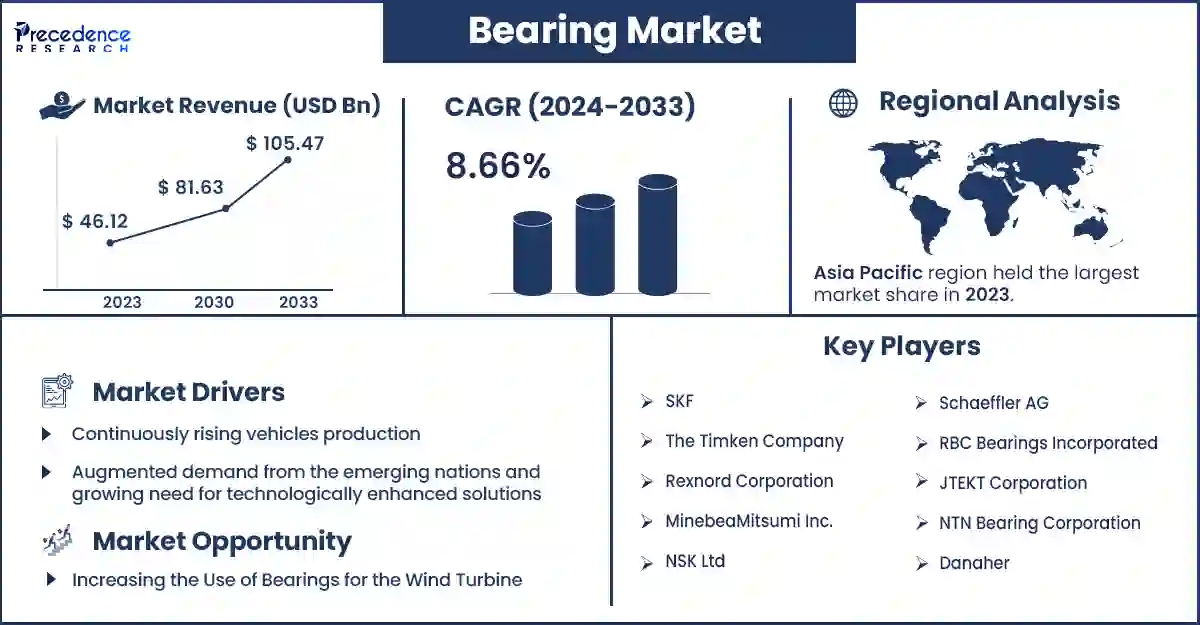Bearing Market Revenue to Attain USD 1105.47 Bn by 2033
Bearing Market Revenue and Trends
The global bearing market revenue was valued at USD 49.93 billion in 2024 and is expected to attain around USD 105.47 billion by 2033, growing at a CAGR of 8.66% from 2024 to 2033. The demand for bearings is increasing with the rising use of machinery in various industries. Bearings reduce friction between moving parts and enhance the overall performance of machinery.

Market Overview
Bearings refer to mechanical components that ensure a smooth movement and rotation between machinery and tools. Bearings are found in almost every piece of equipment and machinery, from vehicle parts to household appliances. The increasing need for high-performance bearings drives the market. The rising demand from the automotive sector is one of the major factors driving the market growth. Rising vehicle production and the demand for construction equipment are expected to propel the market growth over the studied period.
Highlights of the Bearing Market Report
- Based on product, the roller bearings segment accounted for the largest share of the market in 2023 due to their increased adoption in heavy-duty machinery. Exceptional high load bearing capacity of these bearings make them suitable for use in multiple applications. They are effective in reducing rotational friction. Moreover, these bearings are cost-effective compared to others.
- Based on material, the metal segment led the market in 2023. This is mainly due to the high usage of metal bearings due to their corrosion resistance and high durability. Materials such as stainless steel and chrome steel are widely used materials to manufacture bearings due to their excellent load carrying capacity, making them suitable for milling machines and construction equipment.
- On the basis of application, the automotive segment dominated the market with the largest share in 2023. This is mainly due to the heightened adoption of bearings in manufacturing vehicles to reduce their weight. The ability of bearings to rotate at high speeds with precision and to reduce noise and vibration makes them suitable for vehicles.
Bearing Market Trends
- Technological advancements: Due to the increased need for high-performance bearings, key market players have begun incorporating advanced sensor units into their products. Sensor modules help digitally monitor the product's acceleration, deceleration, rotation speed, and load-carrying capacity. These advancements help reduce maintenance costs, making them suitable for new businesses.
- Focus on sustainability and energy efficiency: The rising focus on enhancing energy efficiency is one of the major factors boosting the demand for bearings in various equipment. Bearings further reduce maintenance requirements, improve efficiency, and extend equipment's service life.
- Rising demand from the railway sector: The railway sector is focusing on cost reduction and extending the life of rails. Bearings are used in railway gearboxes to absorb the shocks and vibrations created by the force exerted by the traction motor and the wheels as they travel down the tracks. As a result, difficult operating circumstances increase engine maintenance and downtime.
- The surge in demand for precision bearings: The growing need for precise bearings as a result of automation is likely to boost the bearing market. Precision bearings are being more widely used in various industries, including aerospace and automotive. As a result, the surge in demand for precision bearings is driving the growth of the global market during the forecast period.
Bearing Market Coverage
| Report Attribute | Key Statistics |
| Market Revenue in 2024 | USD 49.93 Billion |
| Market Revenue by 2033 | USD 105.47 Billion |
| CAGR | 7.90% from 2024 to 2033 |
| Quantitative Units | Revenue in USD million/billion, Volume in unitsLargest Market |
| Largest Market | Asia Pacific |
| Base Year | 2023 |
| Regions Covered | North America, Europe, Asia-Pacific, Latin America, and Middle East & Africa |
Regional Insights
In 2023, Asia Pacific led the bearing market. The dominance of the region is primarily attributed to the well-established manufacturing infrastructure in countries like India, China, and Japan. Regional companies also stand out to be a dominant player in the global market. Additionally, the rising adoption of bearings in the automotive industry bolstered the market. Bearings are heavily used in vehicles due to their ability to reduce friction and noise, enhancing vehicle performance. Moreover, rapid industrialization is a major factor that contributes to regional dominance.
Europe is expected to witness the fastest growth in the market during the forecast period of 2024 to 2034. The regional market growth is attributed to the rising production of EVs and heavy-duty machinery. This significantly boosts the demand for bearings, which can help enhance the performance of vehicles and machinery.
Bearing Market News
- In November 2024, Thordon Bearings delivered its COMPAC water-lubricated propeller shaft bearing solution to Canadian bulk carriers. This solution eliminates oil leakage risks and offers real-time bearing condition monitoring.
- In October 2024, SKF and DMG MORI collaborated to implement SKF's Insight Super-precision bearing system in machine tool spindles, enhancing performance, reliability, and real-time monitoring.
Market Segmentation
By Product Type
- Plain Bearing
- Ball Bearing
- Four-point Contact
- Self-aligning
- Deep Groove
- Angular Contact
- Others
- Roller Bearing
- Others
By Type
- Mounted Bearing
- Unmounted Bearing
By Material
- Metal
- Stainless Steel
- Chrome Steel
- Carbon Steel
- Brass
- Others
- Plastic
- Ceramic
By Distribution Channel
- OEM
- Aftermarker
By Size
- 30 to 40
- 41 to 50
- 51 to 60
- 61 to 70
- 70 & above
By Application
- Electrical
- Construction
- Aerospace
- Automotive
- Power Transmission
- Oil & Gas
Get this report to explore global market size, share, CAGR and trends, featuring detailed segmental analysis and an insightful competitive landscape overview@ https://www.precedenceresearch.com/checkout/1020
You can place an order or ask any questions, please feel free to contact at sales@precedenceresearch.com | +1 804 441 9344